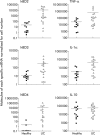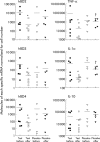Synbiotic therapy (Bifidobacterium longum/Synergy 1) initiates resolution of inflammation in patients with active ulcerative colitis: a randomised controlled pilot trial
- PMID: 15647189
- PMCID: PMC1774839
- DOI: 10.1136/gut.2004.044834
Synbiotic therapy (Bifidobacterium longum/Synergy 1) initiates resolution of inflammation in patients with active ulcerative colitis: a randomised controlled pilot trial
Abstract
Background and aims: Ulcerative colitis (UC) is an acute and chronic inflammatory disease of the large bowel with unknown aetiology. The immune response against normal commensal microorganisms is believed to drive inflammatory processes associated with UC. Therefore, modulation of bacterial communities on the gut mucosa, through the use of probiotics and prebiotics, may be used to modify the disease state.
Methods: A synbiotic was developed for use in UC patients combining a probiotic, Bifidobacterium longum, isolated from healthy rectal epithelium, and a prebiotic (Synergy 1), a preferential inulin-oligofructose growth substrate for the probiotic strain. Treatment was employed in a double blinded randomised controlled trial using 18 patients with active UC for a period of one month. Clinical status was scored and rectal biopsies were collected before and after treatment, and transcription levels of epithelium related immune markers were measured.
Results: Sigmoidoscopy scores (scale 0-6) were reduced in the test group (start 4.5 (1.4), end 3.1 (2.5)) compared with placebo (start 2.6 (2.1), end 3.2 (2.2)) (p=0.06). mRNA levels for human beta defensins 2, 3, and 4, which are strongly upregulated in active UC, were significantly reduced in the test group after treatment (p=0.016, 0.038, and 0.008, respectively). Tumour necrosis factor alpha and interleukin 1alpha, which are inflammatory cytokines that drive inflammation and induce defensin expression, were also significantly reduced after treatment (p=0.018 and 0.023, respectively). Biopsies in the test group had reduced inflammation and regeneration of epithelial tissue.
Conclusions: Short term synbiotic treatment of active UC resulted in improvement of the full clinical appearance of chronic inflammation in patients receiving this therapy.
Figures




Comment in
-
Synbiotic therapy for ulcerative colitis.Gut. 2005 Sep;54(9):1346. doi: 10.1136/gut.2005.070599. Gut. 2005. PMID: 16099808 Free PMC article. No abstract available.
-
Probiotics, prebiotics, synbiotics: ecological treatment for inflammatory bowel disease?Gut. 2006 Dec;55(12):1692-3. doi: 10.1136/gut.2004.051458. Gut. 2006. PMID: 17124152 Free PMC article.
Similar articles
-
Mucosal bacteria in ulcerative colitis.Br J Nutr. 2005 Apr;93 Suppl 1:S67-72. doi: 10.1079/bjn20041347. Br J Nutr. 2005. PMID: 15877898
-
A randomized controlled trial on the efficacy of synbiotic versus probiotic or prebiotic treatment to improve the quality of life in patients with ulcerative colitis.Nutrition. 2009 May;25(5):520-5. doi: 10.1016/j.nut.2008.11.017. Epub 2009 Feb 8. Nutrition. 2009. PMID: 19201576 Clinical Trial.
-
Synbiotic supplementation containing Bifidobacterium infantis and xylooligosaccharides alleviates dextran sulfate sodium-induced ulcerative colitis.Food Funct. 2020 May 1;11(5):3964-3974. doi: 10.1039/d0fo00518e. Epub 2020 May 13. Food Funct. 2020. PMID: 32400787
-
Development, validation and implementation of an in vitro model for the study of metabolic and immune function in normal and inflamed human colonic epithelium.Dan Med J. 2015 Jan;62(1):B4973. Dan Med J. 2015. PMID: 25557335 Review.
-
Synbiotic therapy: a promising new adjunctive therapy for ulcerative colitis.Nutr Rev. 2006 Mar;64(3):132-8. doi: 10.1111/j.1753-4887.2006.tb00196.x. Nutr Rev. 2006. PMID: 16572600 Review.
Cited by
-
Roles of the Polyphenol-Gut Microbiota Interaction in Alleviating Colitis and Preventing Colitis-Associated Colorectal Cancer.Adv Nutr. 2021 Mar 31;12(2):546-565. doi: 10.1093/advances/nmaa104. Adv Nutr. 2021. PMID: 32905583 Free PMC article. Review.
-
Reduced diversity and altered composition of the gut microbiome in individuals with myalgic encephalomyelitis/chronic fatigue syndrome.Microbiome. 2016 Jun 23;4(1):30. doi: 10.1186/s40168-016-0171-4. Microbiome. 2016. PMID: 27338587 Free PMC article.
-
Probiotics increase T regulatory cells and reduce severity of experimental colitis in mice.World J Gastroenterol. 2013 Feb 7;19(5):742-9. doi: 10.3748/wjg.v19.i5.742. World J Gastroenterol. 2013. PMID: 23430765 Free PMC article.
-
Probiotic treatments for induction and maintenance of remission in inflammatory bowel diseases: a meta-analysis of randomized controlled trials.Clin J Gastroenterol. 2014 Feb;7(1):1-13. doi: 10.1007/s12328-013-0440-8. Epub 2013 Dec 28. Clin J Gastroenterol. 2014. PMID: 26183502
-
A Novel Non-Digestible, Carrot-Derived Polysaccharide (cRG-I) Selectively Modulates the Human Gut Microbiota while Promoting Gut Barrier Integrity: An Integrated in Vitro Approach.Nutrients. 2020 Jun 29;12(7):1917. doi: 10.3390/nu12071917. Nutrients. 2020. PMID: 32610452 Free PMC article.
References
-
- Macdonald TT, Monteleone G, Pender SLF. Recent developments in the immunology of inflammatory bowel disease. Scand J Immunol 2000;51:2–9. - PubMed
-
- Schultsz C , Van Den Berg FM, Ten Kate FW, et al. The intestinal mucus layer from patients with inflammatory bowel disease harbors high numbers of bacteria compared with controls. Gastroenterology 1999;117:1089–97. - PubMed
-
- Butcher EC. Leukocyte-endothelial cell recognition: three (or more) steps to specificity and diversity. Cell 1991;67:1033–6. - PubMed
Publication types
MeSH terms
Substances
LinkOut - more resources
Full Text Sources
Other Literature Sources
Medical
